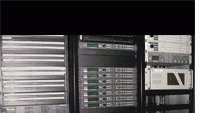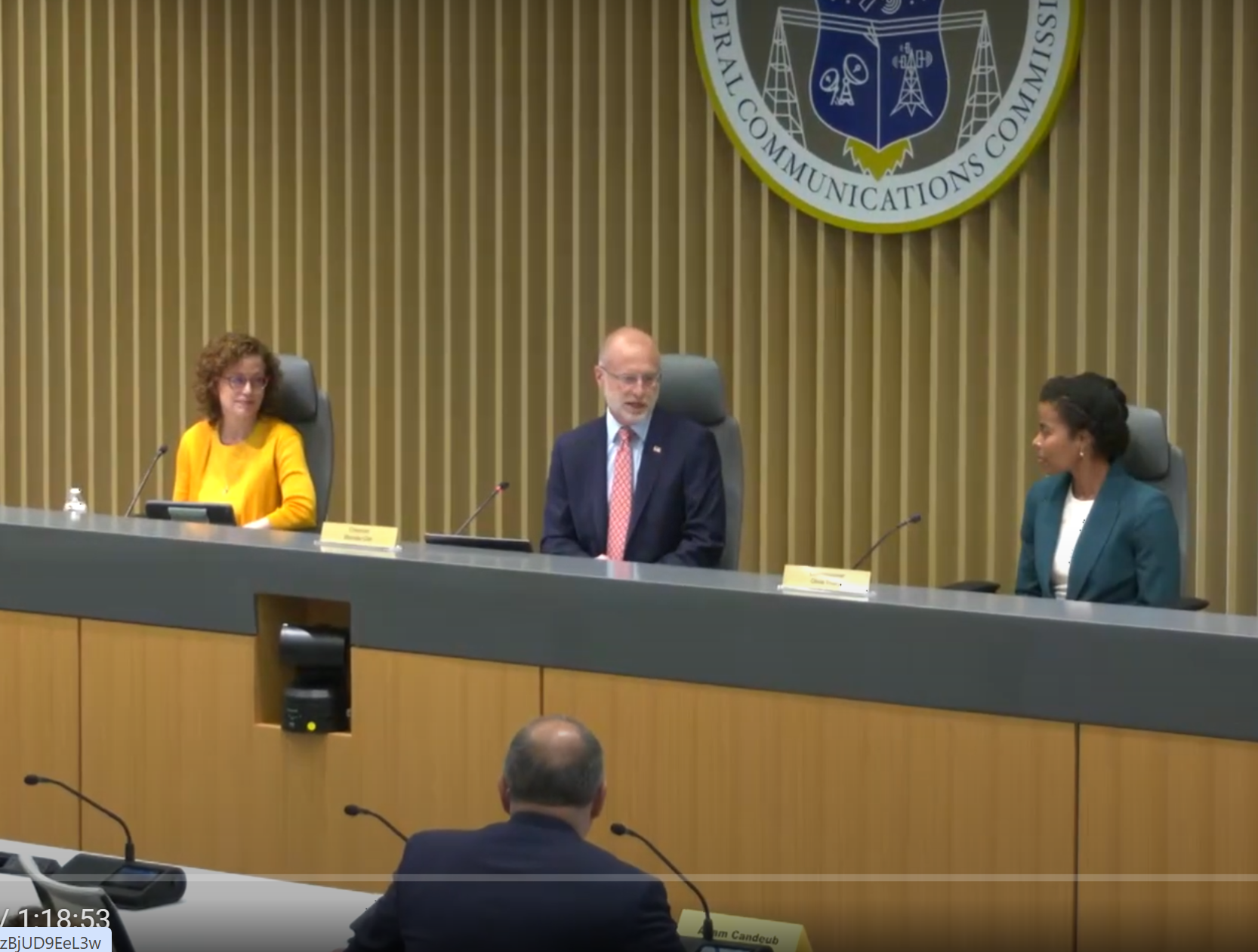Trends in connectivity

Video servers have changed the landscape of facility design. Many facilities have enjoyed a one-third reduction in overall routing requirements simply by moving from tape- to server-based playout. And consolidating ingest, playout and tape-setup operations in a single, storage-area-network (SAN)-based server has afforded many facilities an even greater reduction in required routing capacity.
At News 12 network, analog tie lines are implemented over fiber. Eight DPS-575s convert the analog fiber to/from SDI into the Leitch Integrator routing switcher.
But traditional video servers alone cannot ultimately satisfy all routing requirements. Additionally, business models for pure centralcasting architectures are often hampered by unsolved issues such as “last mile” availability and centralized redundancy. Also, there is an increased demand for specialized content and localized programming.
Believe it or not, video servers and routers are really not that different. Both carry out commands to move video and audio around a facility. The commands can be manual, automated or both, depending on workflow demands. These similarities suggest that the functions of both can be combined. A hybrid router-server can improve a facility’s ROI by providing improved workflow, scalable operations (both centralized and decentralized), and instant availability of stored material. By using interoperable router-server systems, a facility can accommodate a dynamic mix of centralized and localized services, allowing them to coexist seamlessly with content.
The historic need for large, everything-to-everything routing has started to shift to a more cost-effective approach – namely, routing only those signal paths needed for simultaneous playout instead of routing every possible signal path. The most practical and economical architecture for this is a collection of localized hybrid router-server domains. These domains use cost-effective, high-reliability, small-to-midsize routers for local facility routing, and they use the SAN for direct-server routing and remote-content access. This approach can deliver advantages such as affordability, scalability and system flexibility to facilitate the ideal mix of centralized and localized capabilities.
Ingest operations are simplified at News 12 by having both the Leitch VRNet Server solution and the Integrator router system managed by a single operator. A hybrid router-server solution improves ROI through improved workflow.
Why the paradigm shift?
The professional video industry's #1 source for news, trends and product and tech information. Sign up below.
A large central router has always been considered the primary “core” component of a broadcast facility. All possible sources that may potentially provide externally or internally generated content are wired to well-known input ports on the central router. All required output channels – or source points for downstream processing – are wired to router output ports. Everything is well understood and, at the touch of a button, you can instantly set up any desired signal path provided that it has been accounted for in the wiring plan.
This is all fine, assuming that the content is available at the specific ingest port when it is needed. Obviously, routing a VTR to anywhere without having a tape installed is pointless. After all, it is the content we want, not the black and silent output from an empty VTR. Since we will have to route this path at some point in time, we have to consider the routing requirement and allocate the port, which results in an inefficiency in overall port use. Also, we may need a specific type of downstream processing only a fraction of the time, or we may have omitted it altogether from the routing plan. Either we have to pre-allocate the specific routing resources, or we have to re-wire this operation through error-prone patch panels. These large core routers also suffer from inefficient crosspoint use because of the partitioning required to segment signal distribution into protected distribution domains.
ews 12 Network chose the Leitch VRNet Server system with Fibre Channel storage. This 2TB SAN solution inherently reduces the amount of router ports by one-third over traditional tape-based systems.
Now consider how this scenario improves as we introduce servers into the equation. We can replace a large portion of the required facility routing by combining several servers (capable of supporting multiple ingest and playout channels) and a local SAN. Not only do the benefits of random-access storage and playback reduce the need to have multiple VTRs for continuous playout, but the inherent distributed nature of the SAN makes all content available for immediate real-time playout, edit or processing as desired. Also, since each server input and output has unrestricted and non-blocked access to all content stored within it, along with real-time access to content stored elsewhere within the network, any program accessible by the server is internally routable. This eliminates the need for hard-wiring or pre-allocating router resources. Both servers and routers support effective control mechanisms to provide various levels of access security that is critical to shared-content environments.
This is not to say that we can entirely replace facility routing with direct server routing; but it does suggest that more cost-effective, small to mid-sized routers and utility routers can handle most of the remaining routing requirements. With today’s comprehensive control systems, multiple routers can be installed and controlled within a single facility or across facilities, making the hardware infrastructure virtually seamless to the operator.
Partitioning services – centralized vs. distributed
Unlike the disjoint and non-interoperable systems of the past, or the idyllic systems envisioned by pure centralcasting models, an effective solution needs to accommodate a dynamic mix of centralized and localized services. As technologies evolve and business models adapt, broadcast facilities will need to capitalize on these changes by deploying cost-effective and scalable systems that will enable central services and content to coexist seamlessly with local services and content.
For example, the choice between push and pull distribution models depends largely on the context of the service we’re providing. Distributing core programming or global news material will likely require a push model with control over distribution channels, quality monitoring and playout statistics. Local programming or interactive services will likely necessitate pull models. Ideally, these different types of distribution strategies will coexist within a single local facility and will operate simultaneously.
To support the required mix between centralized and distributed services, we need a hybrid strategy based on a SAN architecture coupled with peripheral facility routing. Server ingest and playout, storage, gateways and other LAN-based equipment share access to local content, remote content through WAN gateways, and other network resources. This network topology also provides for direct server routing for server-based ingest and playout.
A case in point
An example of Leitch’s hybrid system is implemented at News 12 in Long Island, NY. The system provides content management of single or multiple domains with activities such as view, search, copy, move and delete files. News 12 is planning to manage all assets with VRMediaNet, which has an SQL database providing an instantaneous view of online, near-line, offline and low-resolution proxy storage across multiple domains.
Figure 1. The combination of routers and servers creates a cost-effective hybrid domain simplifying operations within and among facilities. This strategy is based on a SAN architecture employing both server routing and facility routing.
Small local facility routers provide routing to other local equipment in the facility such as additional processing or QC equipment. Partitioning the router ensures that live feeds never go directly to air without going through the plant QC. This is the same for all ingested material on the servers. Remote access to live or other critical content is also possible through inter-facility router tie lines. This topology allows for flexible access and monitoring of both local and remote content at the appropriate quality of service. Figure 1 illustrates this topology.
Figure 2. A combination of WAN and interfacility tie-line connections provide a solid foundation for content sharing across the News 12 Network with operations in Long Island, Connecticut, New Jersey, Westchester and the Bronx. As additional sites are added, WAN and tie-line traffic can be easily tailored to satisfy varying operational requirements.
The full distributed solution consists of many hybrid domains interconnected by remote WAN and tie line links. This will provide the improved routing efficiency, along with the added flexibility of homogeneous localized or distributed access to media assets and content. Figure 2 shows this topology.
Key advantages of this solution are:
- Lower cost, improved router efficiency and better crosspoint and port-use efficiency
- Improved flexibility in terms of accommodating complex route paths dynamically
- Scalability in both network and tie line bandwidth on an as-needed basis
- Ability to optimize the storage location of network content and media assets for efficient distribution as required
- Preservation of managed full-bandwidth connectivity through facility router tie lines (for live or other specific programming)
- Capability of accessing low-resolution proxies for remote content browsing
- Extended file protection with ability to mirror systems to multiple locations for full redundancy.
Critical capabilities that are key to successful deployment are:
- Integrated command-and-control with the ability to manage potentially competing central and local priorities
- Media-asset and content management
- Content security and access control
- Resource management for ingest, playout and processing resources
- Network and bandwidth management
- Monitoring and reporting of content distribution and system use
- User-configurable GUIs for customized control and monitoring, simplified operations and management of complex networks.
Interoperability
Just as VTR formats change and improve, so do native storage formats and file structures on video servers. Providing for both multiple and standard formats such as DV, MPEG, SD and HD on the same server is key to successful implementation. Interconnection between various systems within and across facilities demands multi-vendor integration. Material eXchange Format (MXF), Advanced Authoring Format (AAF), Media Object Server (MOS) interface protocol and Simple Network Management Protocol (SNMP) ensure compliance.
Looking ahead
The dynamic technologies and changing business models that drive the current broadcast environment will likely continue to complicate business decisions for the foreseeable future. Hybrid solutions that embrace these changes – while at the same time offering customers a consistent and reliable set of resources and strategies that scale well to various types of applications – will remain the best alternative.
Stan Moote is senior vice president, Todd Roth is vice president of technology in the server division, and Steve Sulte is software systems architect in the VP&D division of Leitch Technology.
